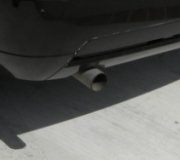Hi James,
There are two kinds of back fires, one is produced from the engine air intake and the other is produced from the tail pipe of the exhaust system. The cause for this backfire condition can vary depending on the malfunction of a particular system. Some backfires can be extreme enough to cause damage to related components. Anytime a backfire is observed immediate diagnosis and repair is needed. If the engine is running rough it can produce a backfire. If the engine is misfiring while it is backfiring please visit why does my engine run rough? It is important to observe the location of the backfire. The sections below are separated into two sections, the first section contains possible causes for backfires in the engine intake. The second section contains possible causes for backfires in the exhaust system.
Car Repair Guide - Backfire In The Engine Intake System
Step 1 - The ignition system in your car is designed to operate at a specific voltage and amperage output. If this voltage/amperage is forced to "spike" due to faulty or inferior tune up parts it could cause the system to "crossfire". A crossfire condition can allow the electrical discharge for a particular spark plug circuit to transfer to a alternative cylinder. Depending on were the cylinder is in the combustion process it can produce a backfire in either the intake or exhaust systems. Always replace ignition components on a regular mileage schedule and use high quality replacement parts.
Step 2 - Engine timing is to be set at a specific degree in relation to the crankshaft of the engine. If this timing becomes miss aligned it can cause low power, poor gas mileage, engine ping and backfiring. To check the engine timing locate the number one cylinder of the engine. This number one cylinder will be the forward most cylinder of the engine. On straight 4 and 6 cylinders engines it is pretty obvious, but on "V" style of engines like the v8 it is a little more tricky. The cylinders heads on every "V" style of engine are offset from one to the other. One cylinder head is more forward than the other. The most forward cylinder head is the side of the engine were the number one cylinder is located. The forward most cylinder is the number one cylinder.
Next, locate the crankshaft timing marks, most engines timing marks are at the front of the engine on the harmonic balancer. Near the balancer there is a small pointer or scale to align the balancer mark too. When the engine is running this gauge or pointer should align with the mark on the balancer. When the engine is running the timing light will strobe and illuminate the balancer mark as it spins. To adjust the timing loosen the distributor and turn slightly one way or the other to achieve the desired setting. Once an adjustment has been made re-tighten the distributor hold down bolt or bolts. Some engine's timing marks are located at the rear of the engine on the flywheel. Before you begin start and run the engine until warmed to operating temperature. Connect the positive and negative leads of a timing light to the battery. Observe the timing tag either on the engine or engine compartment for the timing specification and procedure. If the specification and instruction cannot be found consult a car repair manual.
Step 3 - The ignition system in your car is designed to operate at high voltage. If moisture is present inside of components like the distributor cap it can cause internal ignition crossfire. This crossfire condition can allow the electrical discharge for a particular spark plug circuit to transfer to a alternative cylinder. Depending on were the cylinder is in the combustion process it can produce a backfire in either the intake or exhaust systems. To check for this condition remove the distributor cap and inspect for moisture. If moisture is present dry components thoroughly and reassemble. (Some cars are not equipped with a distributor)
Step 4 - The engine in your car is designed to run on a specific ratio of air to fuel (14 to 1). If this ratio increases by withholding fuel it can cause the engine to back fire through the intake system. The number one reason for this condition is a plugged fuel filter. If your fuel filter has not been changed for over 30,000 miles it probably needs to be changed. Remove the fuel filter and inspect if dirt is observed replace the filter. How to change a fuel filter. (Note: some cars fuel filter is located in the gas tank and are not serviceable).
Step 5 - Your engine's fuel injection system is designed to supply fuel from the gas tank under a specific pressure. If this pressure is allowed to decrease intermitted or regularly by a faulty fuel pump it can cause an engine backfire. Fuel pump that fails intermitted can be tricky to find. Check fuel pump pressure.
.
SPONSORED LINKS
Sunday, February 8th, 2009 AT 5:05 PM




